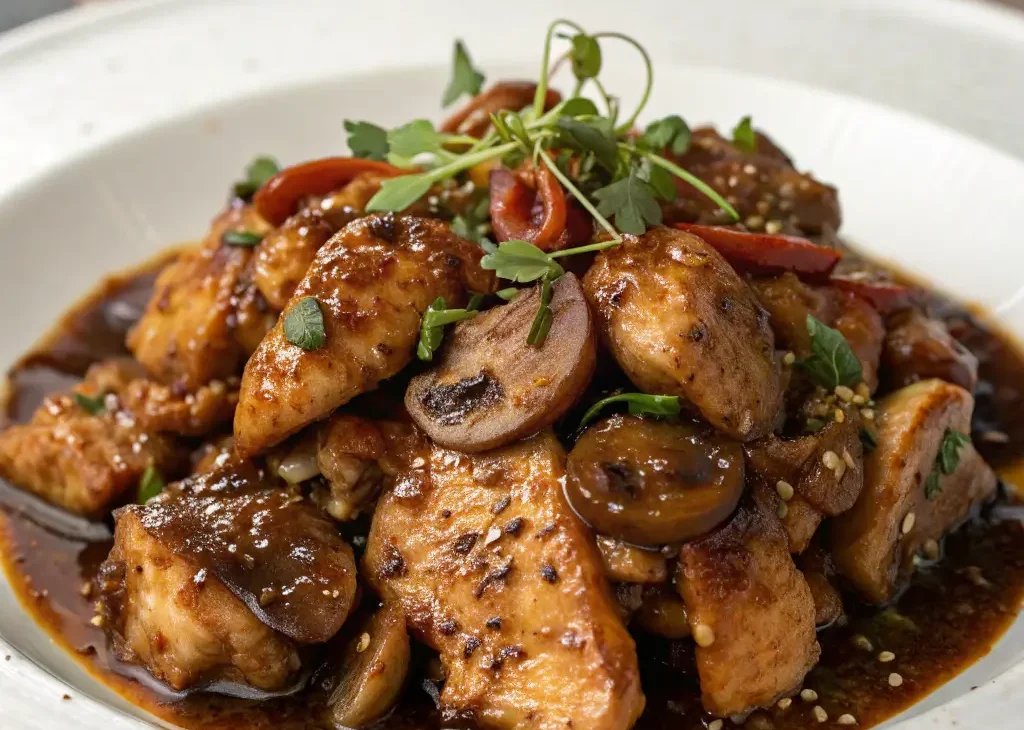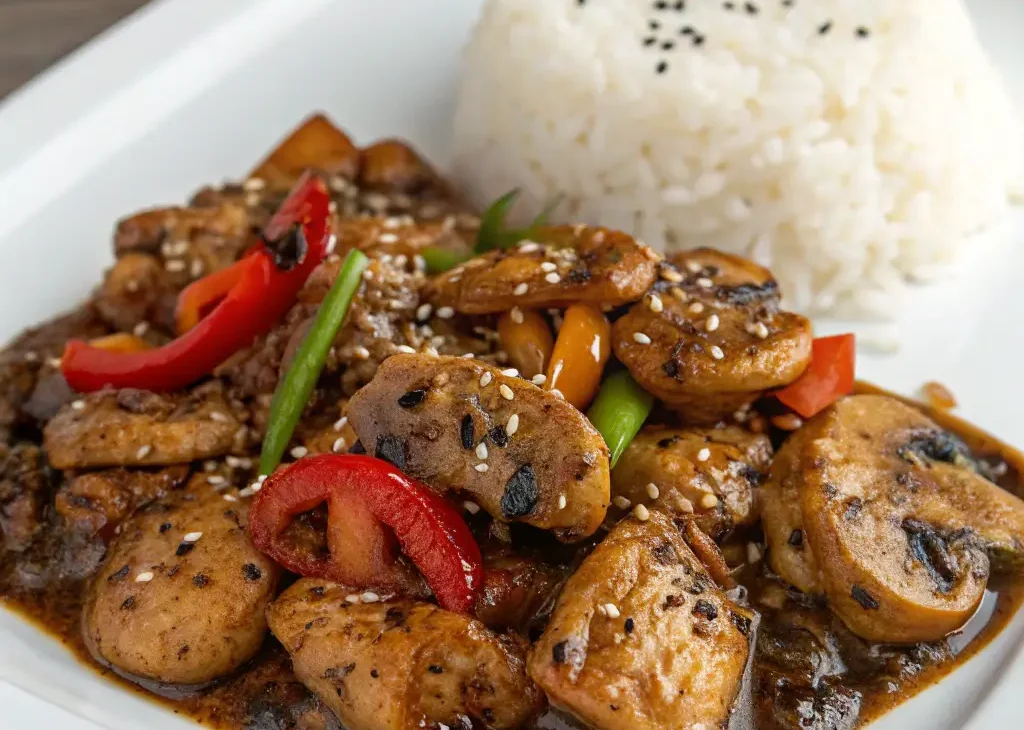Black Pepper Chicken with Mushrooms: A Masterclass in Umami-Rich Stir-Frying
The Art and Science of This Classic Dish
Black Pepper Chicken with Mushrooms represents the pinnacle of wok cooking – a dish where technique and ingredient quality converge to create something greater than the sum of its parts. This Cantonese-inspired stir-fry showcases how black pepper, often relegated to background seasoning in Western cooking, can take center stage when handled properly. The key lies in using freshly cracked peppercorns (preferably Tellicherry or Malabar varieties) which contain higher concentrations of piperine and essential oils compared to pre-ground pepper, delivering both heat and complex floral notes.

The mushrooms in this dish serve multiple purposes beyond texture – their natural glutamates amplify the umami of the chicken while their porous structure absorbs the flavorful sauce. When selecting mushrooms, consider these varieties:
- Shiitake (80-90% water content): Provides meaty texture and woodsy flavor
- Oyster (75-85% water): Delicate texture with subtle sweetness
- Maitake (70-80% water): Feathery texture that soaks up sauce beautifully
- King Trumpet (60-70% water): Meaty bite that holds shape well
The Chemistry of Flavor Development
Understanding the Maillard reaction is crucial for this dish. When chicken reaches 280-330°F (140-165°C), amino acids and reducing sugars create hundreds of new flavor compounds. The mushrooms undergo similar transformations – their cell walls break down at 212°F (100°C), releasing glutamates and intensifying their savory character.
The sauce’s viscosity comes from:
- Cornstarch (forms a gel at 144-162°F/62-72°C)
- Oyster sauce (contains natural thickeners from caramelized sugars)
- Reduced stock (concentrated collagen proteins)
Advanced Preparation Techniques
The Velveting Process Demystified
Professional kitchens achieve that signature tender texture through:
- Alkaline treatment (baking soda at 0.25% by weight for 15 minutes)
- Enzymatic tenderizing (papain or bromelain in marinades)
- Thermal control (blanching at 160°F/71°C for 90 seconds)
For home cooks, our simplified marinade works nearly as well:
- 1 tbsp cornstarch (creates protective coating)
- 1 tbsp oil (lubricates muscle fibers)
- One egg white (denatures at lower temp than yolks)
- 1 tsp baking soda (raises pH to retain moisture)
Wok Temperature Management
Use these visual cues:
- 200°C/400°F: Water droplets skate across surface
- 230°C/450°F: Oil shimmers and barely smokes
- 260°C/500°F: Oil ripples visibly and smokes steadily
Regional Variations Across Asia
Hong Kong Style
- Uses premium abalone mushrooms
- Includes Chinese celery
- Sauce thickened with reduced chicken jus
Singaporean Version
- Incorporates belacan (shrimp paste)
- Adds curry leaves
- Finished with calamansi lime
Japanese Adaptation
- Features maitake and enoki mushrooms
- Uses sake in marinade
- Garnishes with sansho pepper
Nutritional Breakdown & Health Benefits
Macronutrient Profile (per serving)
| Nutrient | Amount | % Daily Value |
|---|---|---|
| Calories | 420 | 21% |
| Protein | 38g | 76% |
| Carbs | 18g | 6% |
| Fat | 22g | 34% |
Key Micronutrients
- Selenium (chicken): 40% DV – supports thyroid function
- Ergothioneine (mushrooms): Unique antioxidant
- Piperine (pepper): Enhances nutrient absorption
- Vitamin D (sun-exposed mushrooms): Up to 100% DV
Professional Kitchen Secrets
Sauce Emulsification
Restaurants achieve glossy sauces by:
- Building fond properly (those browned bits)
- Adding liquids in stages
- Using cornstarch slurry at 1:2 ratio (never more than 1 tsp per serving)
- Finishing with “swirl and tilt” technique
Mushroom Preparation
Michelin-starred methods include:
- Dry sautéing to remove moisture first
- Separate cooking of different mushroom types
- Marinating in soy and mirin before cooking

Troubleshooting Common Issues
Problem: Sauce breaks/separates
Solution:
- Remove from heat
- Whisk in 1 tsp cold butter
- Reheat gently
Problem: Mushrooms release too much liquid
Solution:
- Pre-cook separately
- Increase heat to evaporate
- Add cornstarch to absorb
Problem: Pepper tastes bitter
Solution:
- Use fresher peppercorns
- Toast lightly before grinding
- Balance with more sugar
Modernist Approaches
For adventurous cooks:
- Sous vide chicken at 145°F/63°C for 1 hour before searing
- Mushroom powder in sauce for intense flavor
- Spherified black pepper oil as garnish
- Foamed sauce using lecithin
Beverage Pairings
Creative Matches
- Sake nigori (creamy texture mirrors sauce)
- Black pepper gin cocktail (flavor echoing)
- Kombucha (acidic and effervescent)
Cultural Context & Serving Traditions
In Cantonese dining culture, this dish would typically:
- Be served family-style on a rotating tray
- Accompanied by “fan” (rice) to balance flavors
- Eaten with chopsticks and ceramic spoons
- Followed by a cleansing soup course
Sustainability Considerations
Make this dish more eco-friendly by:
- Using pasture-raised chicken (lower carbon footprint)
- Choosing locally foraged mushrooms
- Opting for organic peppercorns (better for soil)
- Utilizing whole vegetables (reduce food waste)
Why This Recipe Stands the Test of Time
Black Pepper Chicken with Mushrooms endures because it:
- Balances all five tastes: Sweet, salty, sour, bitter, umami
- Offers textural contrast: Tender, crispy, velvety
- Adapts to trends: Keto, gluten-free, high-protein
- Scales beautifully: From weeknight dinner to banquet dish
Final Pro Tips
- Pepper Grinding: Crack peppercorns between parchment with a rolling pin for ideal size
- Mise en Place: Have everything measured and prepped before heating wok
- Resting Time: Let cooked chicken rest 3 minutes before slicing
- Final Seasoning: Always taste and adjust with a pinch of salt at the end

